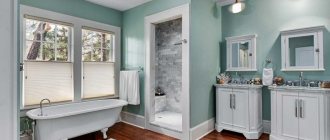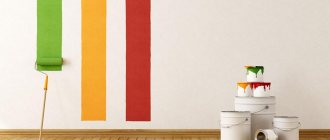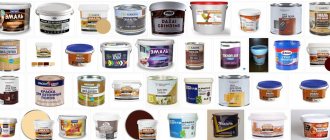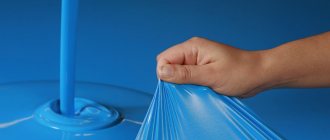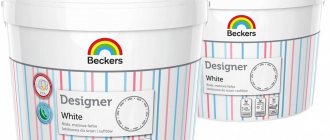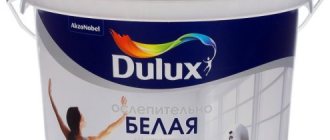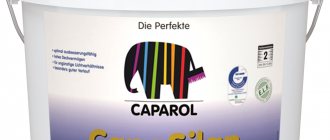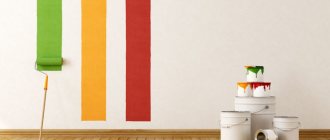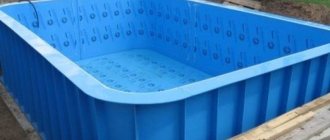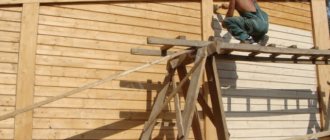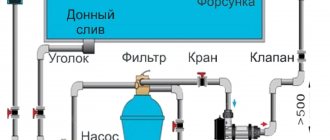A concrete pool is becoming the most popular for country houses. And this is no coincidence; it has a number of advantages over other types:
- Stationary;
- Perennial;
- Budget;
- Involves many design solutions;
- Variety of colors;
- Eco-friendly;
- Durable.
And, of course, it is important for everyone how the pool will look after construction is completed, what finishing materials to use so that the view is beautiful and the costs are low. There are many options for finishing the pool:
- Tile;
- Polypropylene film;
- Mosaic;
- Dye.
The most economical type is to paint the inner bowl of the pool. Today, the building materials market offers a huge range of pool paints. Rubber pool paint has waterproofing properties. What paint is best to paint a swimming pool? Find out here.
The cost of rubber paint varies depending on the manufacturer, the approximate price is from 195 to 400 rubles. per kg.
Rubber pool paint: pros and cons
Advantages of acrylic material
Rubber paint for swimming pools has a number of advantages that are not available to most paints and varnishes, namely:
- Increased waterproofing layer;
- Elasticity;
- Resistance to temperature changes;
- Resistance to mechanical deformation;
- High degree of adhesion;
- No peeling;
- Easy to apply using a spray gun or by hand;
- Profitable price;
- Versatility of use;
- Waterproof;
- No smell;
- Fire and explosion safety;
- Durability.
Rubber paint is characterized by increased resistance to the negative effects of the external environment, including sea water.
The presented type of paint and varnish products, when applied in two or more layers, has a striking difference from all previously invented products. In terms of tactile sensations, rubber paint literally resembles rubber, pleasant and soft. It can be used to cover any surface, as a result of which it will become matte-smooth, while removing the smallest nicks and cracks.
Learn how to connect a sand filter to your pool.
Prices for plastic bowls for swimming pools: .
Read what to feed crucian carp in the pond.
Rubber paint represents an innovation in water-based acrylic paints. According to environmental studies, the ingredients included in its composition do not pose any harm to the environment and human health throughout the entire period of operation , since no harmful substances are released.
Disadvantages of waterproofing
The only disadvantages include the prohibition of using it for painting furniture, floors or doors. You also need to be extremely careful with solvents that negatively affect rubber paint.
Possessing a wide range of color shades, rubber paint allows novice craftsmen and professional designers to play to their hearts’ content with the most original and daring solutions. The most commonly used color is blue for pool water.
Why paint a concrete bowl?
The main purpose of finishing is to give the concrete maximum water resistance .
The strength and service life of the tank depends on the correct and high-quality painting procedure. For bowls located indoors, internal waterproofing is sufficient. It protects the surface from harmful substances contained in water. The destruction of the base is caused by their penetration through small cracks.
If the pool is installed in an open area, external finishing is also required. It is designed to protect the bowl from the negative effects of groundwater and the following external factors:
- Ultraviolet radiation.
- Temperature changes.
- Cleaning with chlorine-containing disinfectants.
- Water pressure.
- Mechanical damage.
Polyacrylic resins in the paint make it resistant to moisture. The surface becomes more elastic, and its expansion and contraction does not damage the appearance.
What outdoor pools can be painted with it?
Often the bowls of outdoor pools are made of concrete. Before tiling the pool, a reinforced mesh is placed on the bowl, after which the tiles are laid. Rubber paint can be applied to both tiles and concrete bases to give a finished and aesthetic look to the new object. Using dark paint will significantly save the cost of heating the pool.
Find out about the types of in-ground pools for your summer cottage at this link.
Another option for installing a summer outdoor pool is to purchase an inflatable rubber one. The feasibility of painting such a pool does not raise any questions, since the rubber coating layer can protect the inflatable surface, as a result of which the pool will serve for many years.
Application
- First of all, it should be noted that the method of applying this type of dye is very different from conventional materials of this kind . This must be taken into account when doing the work yourself, without violating the technology.
Before applying the dye, the surface must be carefully prepared
- First, the surface must be prepared . Metal structures should be thoroughly cleaned to a metallic shine. For these purposes, special tools with attachments made of strong fibers or with abrasive surfaces are used.
- If the paint is applied to concrete or cement base, then it must be rid of potholes, sinks or crumbling elements.
It is not necessary to even out surface differences, but it should be smooth and free of roughness
- At the next stage, the dye is diluted with the solvent in a ratio of 2 to 1, respectively . This composition is used as a primer before painting, covering the surface with a thin layer.
- After the material has dried, the paint should be diluted with a solvent 5 to 2 . This mixture will serve as a kind of binder between the finishing finishing layer and the initial coating. In this case, it is necessary to apply the composition in one direction, even if small stains occur.
Repeated layers should be applied only after the previous ones have completely dried.
- Next, prepare the mixture in a ratio of 5 to 1 . This consistency may seem too thick, but that is exactly what is required. The paint is applied in a direction perpendicular to that which was used in the previous layer.
- As a result, the coating should be quite durable and at the same time it will have shock-absorbing properties , which is sometimes simply necessary in this application.
Advice! It is best to use a paint roller for this type of work. It significantly helps reduce costs and allows you to obtain uniform coverage over the entire area.
The consistency of the dye is quite thick and therefore it is necessary to use a solvent
Painting a concrete pool with liquid blue paint
It is advisable to carry out preparatory work in stages:
- Sand;
- Putty, then sand;
- Treat with primer;
- Degrease the surface;
- Sand all glossy surfaces, if any, to a matte finish;
- Rinse the area with water and dry.
If desired, in order to improve the protective properties and reduce paint consumption, after thorough processing, auxiliary layers of putty, primers, and antiseptic compounds can be applied.
Before directly applying liquid rubber, it is important to adhere to the following rules:
- Mix the paint thoroughly before use;
- If necessary, dilute the paint with water, although this is often not required;
- Apply to a dry surface with a brush or roller in a couple of layers. If you work with a sprayer, make sure that the temperature does not drop below five degrees.
- When working, stir the paint product regularly;
- Apply the next layer exclusively to the dried surface of the previous one;
- When finished, be sure to thoroughly rinse your tools.
This material will tell you what rubber coating is for children's playgrounds in the country.
After painting, try to maintain the coating regularly. It is not particularly difficult, but will allow the rubber paint to serve you for a long time. To do this, it is enough to periodically monitor the surface and, if necessary, carry out restoration of the pool:
- Remove rust;
- Apply sealant;
- Carry out coloring.
Washing with soapy water and treating with an antiseptic is allowed.
Swing lounge chairs for a summer house with a canopy are very comfortable.
Reviews of fecal pumps with a grinder: .
Watch the video on how to make a heated greenhouse with your own hands.
How to calculate the amount of material?
Each manufacturer writes the usage rate on the packaging at the rate of grams per square meter. This data must be applied to your own pool and multiplied by the number of layers. You can use the calculator on the seller’s website or calculate everything manually.
First you need to calculate the area of each tank wall and bottom and add these numbers:
- S1 (bottom)=length*width;
- S2 (walls)=height*width;
- S3 (walls)=height*length;
- S (pool)=S1+S2*2+S3*2.
The area of each alcove or recess, if any, is calculated separately. After this, the consumption indicated by the manufacturer is multiplied by the number of square meters. It is recommended to add 5-10% to the final volume.
For a pool with a square bowl, it is easier to calculate the amount of paint, because the walls will have the same area :
- S1=4*4=16 sq.m.;
- S2, S3=4*1.5=6 sq.m.;
- S=6*4+16=40 sq.m.
For example, let’s take paint with a consumption of 180 g per 1 sq.m. 180*40=7 kg 200 g. This is how much paint will be needed to apply one layer. If painting will be done in 2 or 3 (for an old surface) layers, the amount of paint must be multiplied by this number.
Example for a rectangular pool:
- S1=8*4=32 sq.m.;
- S2=1.5*4=6 sq.m.;
- S3=1.5*8=12 sq.m.;
- S=32+6*2+12*2=68 sq.m.
Let's take 120 g/1 sq.m. of paint per painting. 120*68=8 kg 160 g per layer.
Price and manufacturers of liquid rubber
Today, special-purpose paint in Russia can be purchased from various manufacturers. The quality and volume of containers may vary, but below we provide examples of the most popular companies.
| VD-AK-425 | 100 rub./kg |
| Ecoroom | 1193 rub. (14 kg) |
| SuperdDecor | 270 rub./l |
| VDAK 103 | 104 RUR/kg |
| F310 Optimist | 1200 rub. (14 kg) |
Reviews
- Alexey : By covering a pool with rubber paint, the result is an object with a pleasant texture, the desired color, which will not deteriorate and will last for decades. When you apply rubber paint to an old pool, you will get a completely new look!
- Svetlana : With particular reliability, rubber paint can protect products from frost, fungus and rain. Its application is not only a great way to improve the appearance of the pool, but also an excellent way to rehabilitate outdated material.
Kinds
Not every paint sold in hardware stores can be used to paint the tank bowl. You need to choose special compounds designed specifically for swimming pools. There are several such varieties.
Polyurethane
This paint can be applied to concrete, metal, and various types of stone. The polyurethane version is absolutely safe, does not emit harmful chemicals, and work can be carried out both indoors and outdoors. It is best to use two-component paint, which will need to be mixed with a solvent. This coloring will give a beautiful glossy shine.
However, you need to remember that polyurethane dyes will highlight the slightest roughness, so the surface must be perfectly smooth. The tank can be filled with liquid after 12 days.
Chlorinated rubber
This type of paint is highly valued by professionals, and many recommend choosing it. Chlorinated rubber options are most suitable for metal and concrete. They apply well, do not allow moisture to pass through, and are very wear-resistant - the coloring will last for many years. In addition, this hydropaint prevents the formation of stains and mold. Chlorinated rubber dyes can also be used even in salt water.
The downside will be fumes, so painting work should be carried out with gloves and a respirator, and if this is a room, then high-quality ventilation should be provided.
Epoxy
Epoxy paints contain a resin and a hardener. Such dyes can be applied to a wide variety of materials. The paint does not wear off, the coating is durable and has a glossy shine.
We recommend: An original way to paint flower pots
The service life of the coating is at least 20 years, but it is important to follow the painting technology. Before applying paint, you need to prime the surface and wait about 8 hours. Otherwise, the paint may bubble and begin to peel off.
In addition, it is also poisonous, which means it is necessary to protect the mucous membranes and skin.
Acrylic
Acrylic paints are used in a variety of areas of construction and creativity, so it is not surprising that they are also used to paint swimming pools. They can be applied to concrete, ceramics, metal and cement, and painting can be done both at normal and at sub-zero temperatures. The paint does not change the acidity of the water; it is even used for tanks in which fish live. Safe, does not emit harmful compounds. At the same time, acrylic does not withstand impacts well and is also resistant to aggressive cleaning.
Hydrostone
Hydrostone, or polyvinyl chloride paint, is one of the best options for painting the inside of a pool. It is very economical - a maximum of 2 layers are required to give the tank a decent appearance. By connecting to the surface, the paint creates a coating that prevents mold and microbes from developing. Thanks to this, the pool lasts much longer.
The paint does not emit an unpleasant odor, it is fireproof and resistant to salts, various chemicals and temperature changes. However, it is important not to forget that such paint requires careful work with a solvent.
If the rules are not followed, the coating will quickly become unusable.
Video
From this video you will learn how to paint a swimming pool with rubber paint to waterproof the soil.
The absence of harmful substances for the environment will allow you to spend a long time in your favorite pool without fear and not be afraid for the health of your loved ones. Even if you are not an experienced builder or painter, believe me, application will not be difficult, and timely care will save you from cracks, chips and other troubles. The wide selection presented in construction supermarkets will allow you to choose the product that suits you at a reasonable cost. Use rubber paint and make sure it's simple, economical, and most importantly durable!
Maybe
Criterias of choice
When choosing a product for a pool, it is worth considering the material from which the bowl is made. Although the criteria for choosing paint will be similar due to the fact that a primer is applied before painting, each material still has its own nuances.
Qualities required for a concrete pool:
- High elasticity – for filling small roughnesses and irregularities.
- Low penetration - if the paint absorbs well, too much of it will be needed.
- Low water permeability - wet concrete deteriorates quickly, so good insulation is necessary.
- Good adhesion - it is important that the paint layer adheres well, which will prevent the concrete walls from collapsing.
Rubber, PVC and polyurethane paints are best suited for a concrete bowl.
Qualities required for a metal pool:
Low water permeability - to avoid corrosion of the material.- High level of adhesion - the paint should adhere well to a smooth surface.
- Resistance to destruction - moisture can penetrate through cracks in the paint, which provokes rapid corrosion.
- Transformation of corrosion - if there is already rust on the surface.
- Resistance to temperature differences - the heating and cooling times of metal and air are very different.
For metal surfaces, epoxy, rubber and acrylic paint are better suited.
General criteria:
- wear resistance;
- affordable price;
- ease of application;
- resistance to chlorine and other disinfectants;
- non-slip texture (relevant for the bottom and side around the pool).
